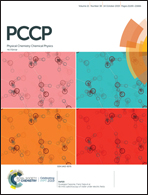Probing self-associated intermolecular H-bonding using low-frequency SERS coupled with mid-IR SERS and DFT study: a case study of 2-MBA adsorbed on ZnO nanoparticles†
Abstract
In the present study, low-frequency SERS is reported for the first time to investigate intermolecular interactions. Low-frequency SERS in the THz region (>50 cm−1) and the mid-IR region is used to probe the H-bonding interaction in 2-mercaptobenzoic acid (2-MBA) molecules adsorbed on the surface of ZnO nanoparticles. The self-association due to H-bonding leads to dimer formation of 2-MBA through carboxylic acid groups. The characteristic Raman bands of the 2-MBA dimer, H-bonded O–H stretching and out-of-plane O–H bending modes, are observed. Subsequently, this dimer formation causes the evolution of two new low-frequency modes at 90 cm−1 (shear dimer in-plane bending) and 110 cm−1 (shear dimer stretching) of intermolecular H-bonding and a blue-shift of the torsional mode of (–COOH) + (–SH). In the THz region (50–200 cm−1) the vibrational modes are blue-shifted, while in the mid-IR region the symmetric out-of-plane O–H bending is red-shifted. The present work shows that SERS can be used to study intermolecular H-bonding of molecules at very low concentrations.



 Please wait while we load your content...
Please wait while we load your content...